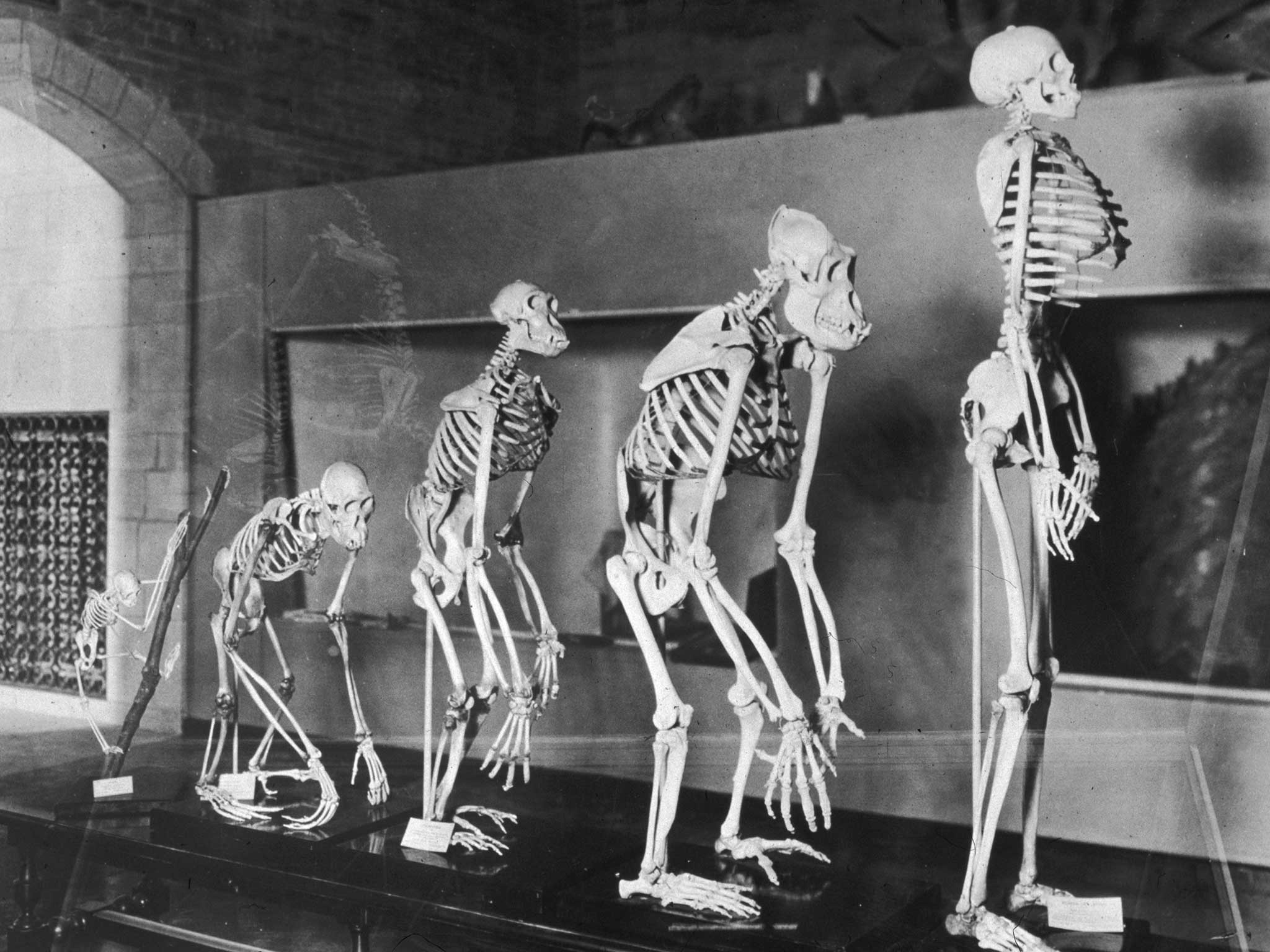Ascent of Man image should be ‘the other way around’, leading expert in human evolution says
‘Chimpanzees and humans are both descended from something more like living humans than living chimpanzees – however uncomfortable that may be to us’

Your support helps us to tell the story
From reproductive rights to climate change to Big Tech, The Independent is on the ground when the story is developing. Whether it's investigating the financials of Elon Musk's pro-Trump PAC or producing our latest documentary, 'The A Word', which shines a light on the American women fighting for reproductive rights, we know how important it is to parse out the facts from the messaging.
At such a critical moment in US history, we need reporters on the ground. Your donation allows us to keep sending journalists to speak to both sides of the story.
The Independent is trusted by Americans across the entire political spectrum. And unlike many other quality news outlets, we choose not to lock Americans out of our reporting and analysis with paywalls. We believe quality journalism should be available to everyone, paid for by those who can afford it.
Your support makes all the difference.The idea that humans evolved from a knuckle-dragging ape, leaving chimpanzees in the Darwinian dust, was crystallised in the famous ‘ascent of man’ image.
But ongoing research on a 3.7-million-year-old fossilised skeleton of an early type of human could prove the orderly procession is actually the wrong way round, according to a leading expert.
Speaking at the British Science Festival in Swansea, Professor Robin Crompton argued that humans, apes and chimpanzees all evolved from a common ancestor who walked upright and lived in the trees.
So it was the chimps who changed their body shape to allow them to move at high speed on all four limbs, while humans carried on using two.
And upright walking did not evolve after humans descended from the trees and started to move around on the open savannah, but millions of years before this.
In fact, Professor Crompton believes tool use, once seen as one of our defining characteristics, developed when early humans were still in the trees.
As they were walking on their feet, they used their hands to steady themselves on nearby branches and gradually got the idea that sticks could have other uses, according to his theory.
Professor Crompton said the ascent of man image had entered popular culture, but was wrong.
“I’ve got it on a t-shirt … that’s how we are taught things happened,” he told the audience at the festival.
“I’m going to try and persuade you that it’s rather the other way around.
“Chimpanzees and humans are both descended from something more like living humans than living chimpanzees – however uncomfortable that maybe to us.”
He said modern humans were still similar to our ancestors who lived in the forests and could return there if we relearned how.
“We are not animals which abandoned the trees. Was there every really an arboreal-terrestrial transition at all?” Professor Crompton said.
“We haven’t abandoned the trees. We are perfectly good in the trees if we choose to go up there – and take our shoes off.”
The ancient fossil of an Australopithecus hominid – the same genus as the famous Lucy – was found in South Africa in the 1990s, but was only dated last year.
Whereas Lucy was just 1.1 metres tall, the South African fossil, nicknamed Little Foot, was about the same size as a modern Western woman.
According to Professor Crompton, Lucy was a pygmy Australopithecus, much like there are pygmy Homo sapiens today.
Little Foot is the most complete Australopithecus ever found with, crucially, both legs surviving virtually intact.
Professor Crompton, an expert in computer modelling of walking who has worked on Lucy for 20 years, now plans to use Little Foot’s dimensions to establish exactly how she walked.
Twenty years ago, he caused international controversy when he was the first to claim Lucy walked upright much like modern humans do – based on computer models – and he believes Little Foot will finally put the argument to rest.
Speaking to The Independent after his talk, Professor Crompton said: “This is certainly the most complete [Australopithecus] skeleton there is. There’s an utterly complete fore limb with only one hand bone missing and two nearly complete legs.
“We’ll be producing a [computer] model with no guesswork about the size it is. We know how long the limbs were so we can work out exactly how she walked.
“We have done a little of that. The pelvis is a still a bit of a mess, it’s being reconstructed.”
There are still some people who argue Lucy walked on all fours, but Professor Crompton said the numbers of academics who disagreed with him were “getting fewer and fewer”.
A recent study in the journal Nature concluded that Lucy died after falling from a tree and suggested she may have done so because she was unskilled in the trees as she walked on two feet.
But Professor Crompton dismissed this idea, saying there was ample evidence that gibbons and chimpanzees fall from the trees, sometimes sustaining serious injuries.
Another key piece of evidence used by those who believe humans evolved to walk upright on the ground is the human foot. For a long time it was thought to be fixed, rather than flexible like a gorillas foot.
But Professor Crompton and other scientists have found evidence that our foot is kept stiff by muscles and tendons, rather than locked in place by the bones.
“Humans have flexible feet just like other apes. There’s nothing special about them and in particular they resemble the foot of gorillas,” he said.
“There is little special about human feet to suggest they are primarily adapted to life on the ground.
“We are a typical great ape, with great ape feet.”
Join our commenting forum
Join thought-provoking conversations, follow other Independent readers and see their replies
Comments